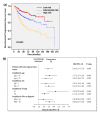The Predictive Role of Prostate-Specific Antigen Changes Following Transurethral Resection of the Prostate for Patients with Localized Prostate Cancer
- PMID: 33383882
- PMCID: PMC7796215
- DOI: 10.3390/cancers13010074
The Predictive Role of Prostate-Specific Antigen Changes Following Transurethral Resection of the Prostate for Patients with Localized Prostate Cancer
Abstract
Regarding localized prostate cancer (PC), questions remain regarding which patients are appropriate candidates for conservative management. Some localized PC was an incidental finding in patients who received transurethral resection of the prostate (TURP) for urinary symptoms. It is known that TURP usually affects the level of prostate-specific antigen (PSA). In the present study, we examined whether changes in PSA levels after TURP possess a predictive value for localized PC. We retrospectively reviewed the clinical data of 846 early-stage PC patients who underwent TURP for urinary symptoms upon diagnosis at our hospital. Of 846 patients, 687 had tumor involvement in TURP specimens, and 362 had post-TURP PSA assessment. Our data revealed that, in addition to low GS and PSA levels at diagnosis, ≤5% tumor involvement in TURP specimens, greater PSA reduction (≥68%) following TURP, and post-TURP PSA ≤ 4 were significantly associated with better progression-free survival (PFS). Survival analysis revealed that the addition of prostate-directed local therapy significantly improved PFS in intermediate- and high-risk groups, but not in the low-risk group. Moreover, in the intermediate-risk group, local therapy improved PFS only for patients who were associated with post-TURP PSA > 4 ng/mL or <68% PSA reduction following TURP. We also found that local therapy had no obvious improvement in PFS for those with post-TURP ≤ 4 ng/mL regardless of pre-TURP PSA. In conclusion, conservative management is considered for patients at low or intermediate risk who have greater PSA reduction following TURP and low post-TURP PSA. Therefore, the levels of PSA following TURP might be helpful for risk stratification and the selection of patients for conservative management.
Keywords: PSA; TURP; conservative management; local treatment; prostate cancer.
Conflict of interest statement
The authors declare no conflict of interest.
Figures






Similar articles
-
[Prostate cancer development after transurethral resection of the prostate--histopathological studies of radical prostatectomy specimens].Nihon Hinyokika Gakkai Zasshi. 2006 May;97(4):649-59. doi: 10.5980/jpnjurol1989.97.649. Nihon Hinyokika Gakkai Zasshi. 2006. PMID: 16768146 Japanese.
-
Hemoglobin-Albumin-Lymphocyte-Platelet (HALP) Score as a Predictive Value of Incidental Prostate Cancer for Patients Going for Transurethral Resection of the Prostate (TURP): A Single-Center Study.Cureus. 2024 Apr 6;16(4):e57736. doi: 10.7759/cureus.57736. eCollection 2024 Apr. Cureus. 2024. PMID: 38716011 Free PMC article.
-
Could the sextant prostate biopsy be replaced by transurethral resection?Arch Ital Urol Androl. 2005 Dec;77(4):194-8. Arch Ital Urol Androl. 2005. PMID: 16444931
-
The Management of Patients Diagnosed with Incidental Prostate Cancer: Narrative Review.Res Rep Urol. 2020 Mar 16;12:105-109. doi: 10.2147/RRU.S245669. eCollection 2020. Res Rep Urol. 2020. PMID: 32215268 Free PMC article. Review.
-
Urinary morbidity and incontinence following transurethral resection of the prostate after brachytherapy.J Urol. 2005 Mar;173(3):808-12. doi: 10.1097/01.ju.0000152698.20487.0e. J Urol. 2005. PMID: 15711274 Review.
Cited by
-
Incidence and associated factors for incidental prostate cancer among patients who underwent surgery for benign prostatic hyperplasia: first report from Somalia.J Cancer Res Clin Oncol. 2023 Jul;149(7):4041-4046. doi: 10.1007/s00432-022-04319-0. Epub 2022 Aug 29. J Cancer Res Clin Oncol. 2023. PMID: 36036824 Free PMC article.
-
The Role of Transurethral BPH Surgeries in Management of Urinary Symptoms in Prostate Cancer Patients, Narrative Review.Curr Urol Rep. 2024 Oct 1;26(1):7. doi: 10.1007/s11934-024-01229-1. Curr Urol Rep. 2024. PMID: 39352587 Free PMC article. Review.
References
LinkOut - more resources
Full Text Sources
Research Materials
Miscellaneous

